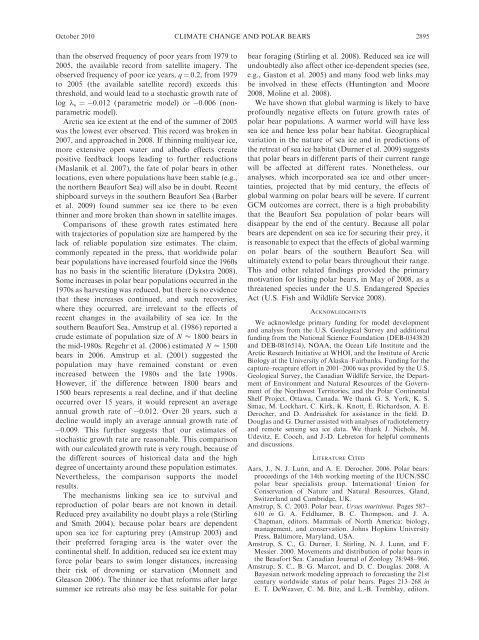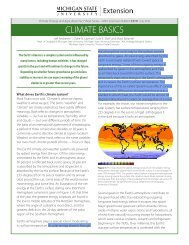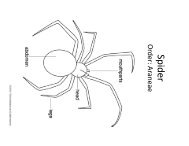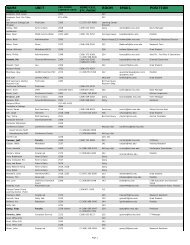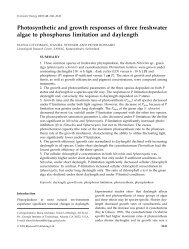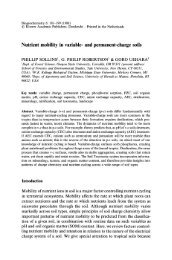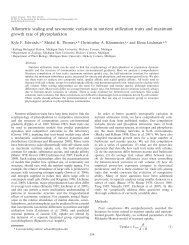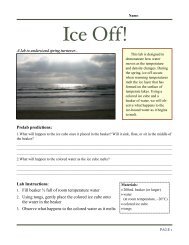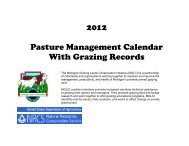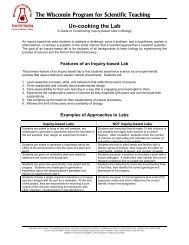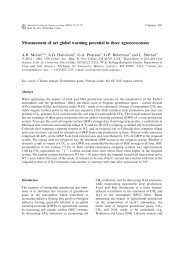October 2010 CLIMATE CHANGE AND POLAR BEARS2895than the observed frequency of poor years from 1979 to2005, the available record from satellite imagery. Theobserved frequency of poor ice years, q ¼ 0.2, from 1979to 2005 (the available satellite record) exceeds thisthreshold, and would lead to a stochastic growth rate oflog k s ¼ 0.012 (parametric model) or 0.006 (nonparametricmodel).Arctic sea ice extent at the end of the summer of 2005was the lowest ever observed. This record was broken in2007, and approached in 2008. If thinning multiyear ice,more extensive open water and albedo effects createpositive feedback loops leading to further reductions(Maslanik et al. 2007), the fate of polar bears in otherlocations, even where populations have been stable (e.g.,the northern Beaufort Sea) will also be in doubt. Recentshipboard surveys in the southern Beaufort Sea (Barberet al. 2009) found summer sea ice there to be eventhinner and more broken than shown in satellite images.Comparisons of these growth rates estimated herewith trajectories of population size are hampered by thelack of reliable population size estimates. The claim,commonly repeated in the press, that worldwide polarbear populations have increased fourfold since the 1960shas no basis in the scientific literature (Dykstra 2008).Some increases in polar bear populations occurred in the1970s as harvesting was reduced, but there is no evidencethat these increases continued, and such recoveries,where they occurred, are irrelevant to the effects ofrecent changes in the availability of sea ice. In thesouthern Beaufort Sea, Amstrup et al. (1986) reported acrude estimate of population size of N ’ 1800 bears inthe mid-1980s. Regehr et al. (2006) estimated N ’ 1500bears in 2006. Amstrup et al. (2001) suggested thepopulation may have remained constant or evenincreased between the 1980s and the late 1990s.However, if the difference between 1800 bears and1500 bears represents a real decline, and if that declineoccurred over 15 years, it would represent an averageannual growth rate of 0.012. Over 20 years, such adecline would imply an average annual growth rate of0.009. This further suggests that our estimates ofstochastic growth rate are reasonable. This comparisonwith our calculated growth rate is very rough, because ofthe different sources of historical data and the highdegree of uncertainty around these population estimates.Nevertheless, the comparison supports the modelresults.The mechanisms linking sea ice to survival andreproduction of polar bears are not known in detail.Reduced prey availability no doubt plays a role (Stirlingand Smith 2004), because polar bears are dependentupon sea ice for capturing prey (Amstrup 2003) andtheir preferred foraging area is the water over thecontinental shelf. In addition, reduced sea ice extent mayforce polar bears to swim longer distances, increasingtheir risk of drowning or starvation (Monnett andGleason 2006). The thinner ice that reforms after largesummer ice retreats also may be less suitable for polarbear foraging (Stirling et al. 2008). Reduced sea ice willundoubtedly also affect other ice-dependent species (see,e.g., Gaston et al. 2005) and many food web links maybe involved in these effects (Huntington and Moore2008, Moline et al. 2008).We have shown that global warming is likely to haveprofoundly negative effects on future growth rates ofpolar bear populations. A warmer world will have lesssea ice and hence less polar bear habitat. Geographicalvariation in the nature of sea ice and in predictions ofthe retreat of sea ice habitat (Durner et al. 2009) suggeststhat polar bears in different parts of their current rangewill be affected at different rates. Nonetheless, ouranalyses, which incorporated sea ice and other uncertainties,projected that by mid century, the effects ofglobal warming on polar bears will be severe. If currentGCM outcomes are correct, there is a high probabilitythat the Beaufort Sea population of polar bears willdisappear by the end of the century. Because all polarbears are dependent on sea ice for securing their prey, itis reasonable to expect that the effects of global warmingon polar bears of the southern Beaufort Sea willultimately extend to polar bears throughout their range.This and other related findings provided the primarymotivation for listing polar bears, in May of 2008, as athreatened species under the U.S. Endangered SpeciesAct (U.S. Fish and Wildlife Service 2008).ACKNOWLEDGMENTSWe acknowledge primary funding for model developmentand analysis from the U.S. Geological Survey and additionalfunding from the National Science Foundation (DEB-0343820and DEB-0816514), NOAA, the Ocean Life Institute and theArctic Research Initiative at WHOI, and the Institute of ArcticBiology at the University of Alaska–Fairbanks. Funding for thecapture–recapture effort in 2001–2006 was provided by the U.S.Geological Survey, the Canadian Wildlife Service, the Departmentof Environment and Natural Resources of the Governmentof the Northwest Territories, and the <strong>Polar</strong> ContinentalShelf Project, Ottawa, Canada. We thank G. S. York, K. S.Simac, M. Lockhart, C. Kirk, K. Knott, E. Richardson, A. E.Derocher, and D. Andriashek for assistance in the field. D.Douglas and G. Durner assisted with analyses of radiotelemetryand remote sensing sea ice data. We thank J. Nichols, M.Udevitz, E. Cooch, and J.-D. Lebreton for helpful commentsand discussions.LITERATURE CITEDAars, J., N. J. Lunn, and A. E. Derocher. 2006. <strong>Polar</strong> bears:proceedings of the 14th working meeting of the IUCN/SSCpolar bear specialists group. International Union forConservation of Nature and Natural Resources, Gland,Switzerland and Cambridge, UK.Amstrup, S. C. 2003. <strong>Polar</strong> bear, Ursus maritimus. Pages 587–610 in G. A. Feldhamer, B. C. Thompson, and J. A.Chapman, editors. Mammals of North America: biology,management, and conservation. Johns Hopkins UniversityPress, Baltimore, Maryland, USA.Amstrup, S. C., G. Durner, I. Stirling, N. J. Lunn, and F.Messier. 2000. Movements and distribution of polar bears inthe Beaufort Sea. Canadian Journal of Zoology 78:948–966.Amstrup, S. C., B. G. Marcot, and D. C. Douglas. 2008. ABayesian network modeling approach to forecasting the 21stcentury worldwide status of polar bears. Pages 213–268 inE. T. DeWeaver, C. M. Bitz, and L.-B. Tremblay, editors.
2896 CHRISTINE M. HUNTER ET AL.Ecology, Vol. 91, No. 10Arctic sea ice decline: observations, projections, mechanisms,and implications. Geophysics monograph series 180. AGU,Washington, D.C., USA.Amstrup, S. C., T. L. McDonald, and I. Stirling. 2001. <strong>Polar</strong>bears in the Beaufort Sea: a 30 year mark–recapture casehistory. Journal of Agricultural, Biological, and EnvironmentalStatistics 6:221–234.Amstrup, S. C., I. Stirling, and J. W. Lentfer. 1986. Past andpresent status of polar bears in Alaska. Wildlife SocietyBulletin 14:241–254.Amstrup, S. C., I. Stirling, T. S. Smith, C. Perham, and G. W.Thiemann. 2006. Recent observations of intraspecific predationand cannibalism among polar bears in the southernBeaufort Sea. <strong>Polar</strong> Biology 29:997–1002.Anderson, D. R. 2007. Model-based inference in the lifesciences: a primer on evidence. Springer-Verlag, New York,New York, USA.Barber, D. G., R. Galley, M. G. Asplin, R. De Abreu, K.Warner, M. Pucko, M. Gupta, S. Prinsenberg, and S. Julien.2009. The perennial pack ice in the southern Beaufort Seawas not as it appeared in the summer of 2009. GeophysicalResearch Letters 36:L24501.Bergen, S., G. M. Durner, D. C. Douglas, and S. C. Amstrup.2007. Predicting movements of female polar bears betweensummer sea ice foraging habitats and terrestrial denninghabitats of Alaska in the 21st century: proposed methodologyand pilot assessment. Administrative Report. USGSAlaska Science Center, Anchorage, Alaska, USA.Boyd, I., S. Wanless, and C. J. Camphuysen. 2006. Toppredators in marine ecosystems: their role in monitoring andmanagement. Cambridge University Press, Cambridge, UK.Brower, C. D., A. Carpenter, M. L. Branigan, W. Calvert, T.Evans, A. S. Fischbach, J. A. Nagy, S. Schliebe, and I.Stirling. 2002. The polar bear management agreement for thesouthern Beaufort Sea: An evaluation of the first ten years ofa unique conservation agreement. Arctic 55:362–372.Burnham, K. P., and D. R. Anderson. 2002. Model selectionand multimodel inference: a practical information-theoreticapproach. Second edition. Springer-Verlag, New York, NewYork, USA.Caswell, H. 1989. The analysis of life table responseexperiments. I. Decomposition of effects on populationgrowth rate. Ecological Modelling 46:221–237.Caswell, H. 2001. Matrix population models. Second edition.Sinauer, Sunderland, Massachusetts, USA.Caswell, H., and T. Kaye. 2001. Stochastic demography andconservation of an endangered plant (Lomatium bradshawii)in a dynamic fire regime. Advances in Ecological Research32:1–51.Center for Biological Diversity. 2005. Petition to list the polarbear (Ursus maritimus) as a threatened species under theEndangered Species Act. Before the Secretary of the Interior2-16-2005. hhttp://www.biologicaldiversity.org/species/mammals/polar_bear/pdfs/15976_7338.pdfiCherry, S. G., A. E. Derocher, I. Stirling, and E. Richardson.2008. Fasting physiology of polar bears in relation toenvironmental change and breeding behavior in the BeaufortSea. <strong>Polar</strong> Biology 32:383–391.Comiso, J. C. 2006. Arctic warming signals from satelliteobservations. Weather 61:70–76.Convey, P., and R. I. L. Smith. 2006. Responses of terrestrialAntarctic ecosystems to climate change. Plant Ecology 182:1–10.Copas, J. B. 1983. Plotting p against x. Applied Statistics 32:25–31.Cronin, M. A., S. C. Amstrup, S. L. Talbot, G. K. Sage, andK. S. Amstrup. 2009. Genetic variation, relatedness, andeffective population size of polar bears (Ursus maritimus) inthe southern Beaufort Sea, Alaska. Journal of Heredity 100:681–690.DeWeaver, E. 2007. Uncertainty in climate model projectionsof Arctic sea ice decline: an evaluation relevant to polarbears. Administrative Report. USGS Alaska Science Center,Anchorage, Alaska, USA.Durner, G. M., and S. C. Amstrup. 1995. Movements of a polarbear from northern Alaska to northern Greenland. Arctic 48:338–341.Durner, G. M., S. C. Amstrup, R. M. Nielson, and T. L.McDonald. 2004. The use of sea ice habitat by female polarbears in the Beaufort Sea. Report to Minerals ManagementService for OCS Study 2004–14. U.S. Geological Survey,Alaska Science Center, Anchorage, Alaska, USA.Durner, G. M., et al. 2009. Predicting 21st century polar bearhabitat distribution from global climate models. EcologicalMonographs 79:25–58.Dykstra, P. 2008. Magic number: a sketchy fact about polarbears keeps going . . . and going . . . and going. Society ofEnvironmental Journalists, online article 15, Summer 2008.hhttp://www.sej.org/publications/alaska-and-hawaii/magicnumber-a-sketchy-fact-about-polar-bears-keeps-goingandgoing-aniFischbach, A. S., S. C. Amstrup, and D. C. Douglas. 2007.Landward and eastward shift of Alaskan polar bear denningassociated with recent sea ice changes. <strong>Polar</strong> Biology 30:1395–1405.Gaston, A. J., H. G. Gilchrist, and M. L. Mallory. 2005.Variation in ice conditions has strong effects on the breedingof marine birds at Prince Leopold Island, Nunavut.Ecography 28:331–344.Grosbois, V., O. Gimenez, J.-M. Gaillard, R. Pradel, C.Barbraud, J. Clobert, A. P. Moller, and H. Weimerskirch.2008. Assessing the impact of climate variation on survival invertebrate populations. Biological Reviews 83:357–399.Hunter, C. M., H. Caswell, M. C. Runge, E. V. Regehr, S. C.Amstrup, and I. Stirling. 2007. <strong>Polar</strong> bears in the SouthernBeaufort Sea II: demography and population growth inrelation to sea ice conditions. Administrative Report. USGSAlaska Science Center, Anchorage, Alaska, USA.Huntington, H. P., and S. E. Moore. 2008. Arctic marinemammals and climate change. Ecological Applications18(Supplement):S1–S2.IPCC 2007. Summary for policymakers. Pages 1–18 in S.Solomon, D. Qin, M. Manning, Z. Chen, M. Marquis, K. B.Averyt, M. Tignor, and H. L. Miller, editors. <strong>Climate</strong> change2007: the physical science basis. Contribution of WorkingGroup I to the Fourth Assessment Report of the IntergovernmentalPanel on <strong>Climate</strong> <strong>Change</strong>. Cambridge UniversityPress, New York, New York, USA.Jenouvrier, S., H. Caswell, C. Barbraud, and H. Weimerskirch.2009. Demographic models and IPCC climate projectionspredict the decline of an emperor penguin population.Proceedings of the National Academy of Sciences USA106:1844–1847.Keith, D. A., H. R. Akcakaya, W. Thuiller, G. F. Midgley,R. G. Pearson, S. J. Phillips, H. M. Regan, M. B. Araujo,and T. G. Rebelo. 2008. Predicting extinction risks underclimate change: coupling stochastic population models withdynamic bioclimatic habitat models. Biology Letters 4:560–563.Laidre, K. L., I. Stirling, L. F. Lowry, O. Wiig, M. P. Heide-Jorgensen, and S. H. Ferguson. 2008. Quantifying thesensitivity of arctic marine mammals to climate-inducedhabitat change. Ecological Applications (Supplement)18:S97–S125.Maslanik, J. A., C. Fowler, J. Stroeve, S. Drobot, J. Zwally, D.Yi, and W. Emery. 2007. A younger, thinner Arctic ice cover:Increased potential for rapid, extensive sea-ice loss. GeophysicalResearch Letters 34GL032043.Moline, M. A., N. J. Karnovsky, Z. Brown, G. J. Divoky, T. K.Frazer, C. A. Jacoby, J. J. Torres, and W. R. Fraser. 2008.High latitude changes in ice dynamics and their impact onpolar marine ecosystems. Annals of the New York Academyof Sciences 1134:267–319.


